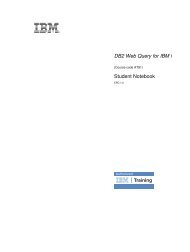IBM Web Content Manager - The IBM Learner Portal is currently ...
IBM Web Content Manager - The IBM Learner Portal is currently ...
IBM Web Content Manager - The IBM Learner Portal is currently ...
You also want an ePaper? Increase the reach of your titles
YUMPU automatically turns print PDFs into web optimized ePapers that Google loves.
11: User access and security<br />
In th<strong>is</strong> section of the course you will learn how to use the access control features of <strong>IBM</strong> <strong>Web</strong> <strong>Content</strong><br />
<strong>Manager</strong> and <strong>Web</strong>Sphere <strong>Portal</strong> to restrict access to a section of your website.<br />
Time required<br />
It should take approximately 3 hours to complete these lessons.<br />
Learning objectives<br />
When you have completed th<strong>is</strong> part of the course you should be able to:<br />
v Restrict access to a section of your site framework<br />
v Restrict access to individual items<br />
v Restrict access to a page<br />
Lesson 11.0.1: Access controls<br />
You can restrict access to selected users and groups to the views within an authoring portlet, the items<br />
managed by the authoring portlet, and items, portlets, and pages d<strong>is</strong>played within a website.<br />
<strong>The</strong>re are multiple access control layers used by <strong>IBM</strong> <strong>Web</strong> <strong>Content</strong> <strong>Manager</strong> and <strong>Web</strong>Sphere <strong>Portal</strong>. Both<br />
use an "inheritance" model in which the access controls set on parent items can be automatically inherited<br />
by their children. Different access control settings can then be applied to individual child items where<br />
required.<br />
<strong>Web</strong>Sphere <strong>Portal</strong> access controls<br />
You can control user access to pages and to specific portlets within <strong>Web</strong>Sphere <strong>Portal</strong>. Access<br />
settings are defined in a parent page and are automatically inherited by any child pages.<br />
Although you cannot define access controls for individual portlets on a page, you can define<br />
access controls for each type of portlet used by your system.<br />
<strong>Web</strong> content libraries<br />
Library-level access controls determine access to the library as a whole. If access <strong>is</strong> granted, it<br />
provides an entry point to the library. A user needs at least contributor access to a library in order<br />
to have access to it on the authoring portlet.<br />
Item types per library<br />
Item type access controls define the item type views and tasks a user can access within the<br />
authoring portlet for a particular library. <strong>The</strong> perm<strong>is</strong>sions set for item types in a library do not<br />
automatically give you access to individual items. <strong>The</strong>y only give you access to specific tasks and<br />
views within the authoring portlet.<br />
Accompanying guide for SPVC - not for d<strong>is</strong>tribution<br />
Item-level access controls<br />
Item-level access controls define the actions that a user can perform on an individual item. For<br />
example, a user with manager access to Components has access to the Purge and Unlock actions<br />
but, if that user does not also have manager access to an individual component, then the Purge<br />
and Unlock actions will not be enabled when that component <strong>is</strong> selected.<br />
Lab 11.1: Adding a Confidential site area and related items<br />
During th<strong>is</strong> lab you will add to your site framework a new site area that will be used to store<br />
confidential content items. Only users belonging to the Executives group will be able to access these<br />
items.<br />
177



